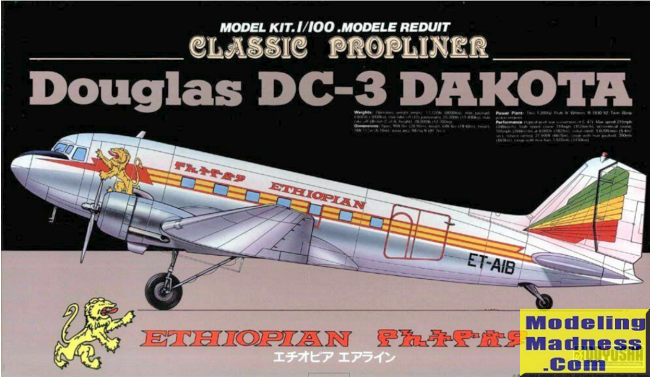
Doyusha 1/100 DC-3 (Ethiopian Air Lines)
| KIT #: | 100-D3-3 |
| PRICE: | 1400 Yen SRP |
| DECALS: | One option |
| REVIEWER: | Scott Van Aken |
| NOTES: |

| HISTORY |
The DC-3 was literally the airliner than got American air line companies into a profitable business. It was fast, comfortable, and able to carry a decent number of passengers. It was also a very capable transport that, thanks in part to WWII, was built in considerable numbers.
The aircraft also made it quite difficult for new types to get into revenue service after WWII. This is because the government was selling them off cheaply as they were no longer needed. A booming business was created to convert the military transports into civil airliners, with the total cost being far less that something new.
Ethiopian Airlines (Amharic: የኢትዮጵያ አየር መንገድ (ye-Ityopya ayer menged); የኢትዮጵያ (ye-Ityopya) for short), formerly Ethiopian Air Lines (EAL) and often referred to as simply Ethiopian, is Ethiopia's flag carrier and is wholly owned by the country's government. EAL was founded on 21 December 1945 and commenced operations on 8 April 1946, expanding to international flights in 1951. The firm became a share company in 1965 and changed its name from Ethiopian Air Lines to Ethiopian Airlines. The airline has been a member of the International Air Transport Association since 1959 and of the African Airlines Association (AFRAA) since 1968.Ethiopian is a Star Alliance member, having joined in December 2011.
Its hub and headquarters are at Bole International Airport in Addis Ababa, from where it serves a network of 125 passenger destinations—20 of them domestic—and 44 freighter destinations. The airline has secondary hubs in Togo and Malawi. Ethiopian is Africa's largest airline in terms of passengers carried, destinations served, fleet size, and revenue. Ethiopian is also the world's 4th largest airline by the number of countries served.
As a note of interest, the airline started with DC-3/C-47s and continued to operate the type well into the 1970s.
| THE KIT |
 This
particular kit was originally issued by Nitto, who
This
particular kit was originally issued by Nitto, who
The kit provides a fair cockpit section that includes the radio room. You have a pair of front seats and a radio operator's seat. There are control wheels and an instrument panel that takes a decal, not that you will see very much in there. There is no cabin and the fairly thick windows are gang joined and fit from the inside so prepainting the fuselage around the windows would be advised. Closing the fuselage halves will trap the tail gear.
Wings are a single lower section with separate upper halves. To the nacelle areas, one attaches the firewall, engine piece and the forward cowlings. Note that you only have the short carb intake in the kit. The prop can be made to rotate. Landing gear is fairly well done and you are provided skis, though I doubt any of the airline versions would have used these. Tailplanes are a single piece and slot into the rear fuselage. There are a number of antennas, but I'd leave these off until the very end to prevent breaking them.
 Instructions
seem to be universal and provide information for bits not used on this kit,
including the building of a fairly complex looking dual long wire antenna for
the underside of the fuselage. Since the instructions are basically all in
Japanese, one isn't really sure which of the two types of prop to use, but I'd
put the paddle blade ones on this one. There are photos of Ethiopian airlines
planes on the
'net so you may wish to use those for reference. Decals are nicely printed and
the placement guide shows another airline scheme so it is obvious that Doyusha
is saving a bit of money on paper. The decals are Japanese 'old school' where
the whites are actually off white. Use the box top for your color information.
The plane is basically white upper fuselage and tail with the rest of the plane
in bare metal. You will also have to paint on the de-icer
boots along with the area around the cockpit. I personally find this livery to
be one of the nicest ever done and have a 1/144 and 1/200 jetliner in this
scheme.
Instructions
seem to be universal and provide information for bits not used on this kit,
including the building of a fairly complex looking dual long wire antenna for
the underside of the fuselage. Since the instructions are basically all in
Japanese, one isn't really sure which of the two types of prop to use, but I'd
put the paddle blade ones on this one. There are photos of Ethiopian airlines
planes on the
'net so you may wish to use those for reference. Decals are nicely printed and
the placement guide shows another airline scheme so it is obvious that Doyusha
is saving a bit of money on paper. The decals are Japanese 'old school' where
the whites are actually off white. Use the box top for your color information.
The plane is basically white upper fuselage and tail with the rest of the plane
in bare metal. You will also have to paint on the de-icer
boots along with the area around the cockpit. I personally find this livery to
be one of the nicest ever done and have a 1/144 and 1/200 jetliner in this
scheme.
| CONCLUSIONS |
June 2019
Copyright ModelingMadness.com. All rights reserved.
If you would like your product reviewed fairly and fairly quickly, please contact the editor or see other details in the Note to Contributors.
Back to the Main Page Back to the Review Index Page Back to the Previews Index Page